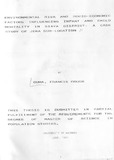| dc.description.abstract | The study of infant and child mortality is important in that, its
level can be used as a measure of social and economic development
of an area. The infant/child mortality rate in Kenya has declined
since independence, to less than 70 per 1000 live births. This
country's rate aggregate masks wide variations across districts and
among the divisions within a district. Such regional variations in
infant and child mortality rates have been shown to be related to
a number of social, economic, cultural and environmental
characteristics of a given area. To specify such linkage we move
in this study, from the district level analysis to the divisional
and individual level in Siaya district, which is one of the three
districts with the highest infant and child mortality in Kenya. The
divisional data is derived from the 1979 census data and the
individual data from a survey conducted in Jera Sub-location of
Ukwala Division by interviewing 415 women aged between 15 and 49
and have given birth.
The objective of this study is to determine the socioeconomic and
environmental risk factors among others which are associated with
infant and child mortality at the divisional and individual level
in Siaya District. The socioeconomic factors at the divisional
level are maternal education, place of residence and marital
status. At the individual level, the socioeconomic factors measured
were maternal and paternal education; maternal labour
participation; religion; marital status; and the number of domestic
animals. The environmental risk factors investigated are housing
conditions; availability and use of a toilet; water source; cooking
and lighting energy; and the concentration in the home. Apart from
these two main factors, maternal and infant/child care from the
time of conception to the early childhood such as quality of family
nutrition; antenatal, natal and postnatal care; and immunization
of children were investigated.
The measures used to estimate infant and child mortality at the
divisional level are infant mortal ity rate, 1qO; chi ld mortal ity
rate, 4q1; probability of dying at age x , q(x); and the life
expectancy at birth, eo . Trussell's technique for estimating child
mortality was used to calculate q(x) and the other estimates were
obtained from a life table which was constructed by the use of q(x)
and the Coale-Demeny life tables. At the individual level the
Preston and Trussell's (1982) technique- of estimating infant and
child mortality index was used to determine the mortality index of
an individual woman.
The findings at the district is as expected, that is infant and
child mortality rates are very high (1QO = 173/1000 and qt z ) =
208.8/1000) resulting in a life expectancy at birth of only 41.2
years. At the divisional level, infant and chi ld mortal ity are
still high although there are variations with Bondo Division having
the lowest and Ukwala Division the highest while Yala Division had
an advantage of Boro Division. An interesting finding at this level
is observed in the time trends which shows a drastic decline in
infant/child mortality between 1963 and 1967. After 1967. the
mortality increased with no sign of decline although the increase
was steady after 1975. The socioeconomic differentials revealed
that infant and child mortality is inversely proportional to the
level of mother's education. Urban residents had a lower infant and
child mortality rates than the rural except in Bondo Divion while
marital status showed that the single women have a low infant and
child mortality rates followed by married, divorced/separated and
finally the widowed. At the individual level, all the hypothesized
relationships were confirmed. The stepwise regression analysis
reveal 1s that pIace of cooking, father's occupation and maternal 1
education have a significant effect on infant and child mortality
at a level of 0.05. At 0.1 level of significance, place of cooking;
father's occupation; maternal education; source of cooking energy;
age at which supplementary food is introduced and visits to
antenatal care significant effect on infant and child mortality. | en |

